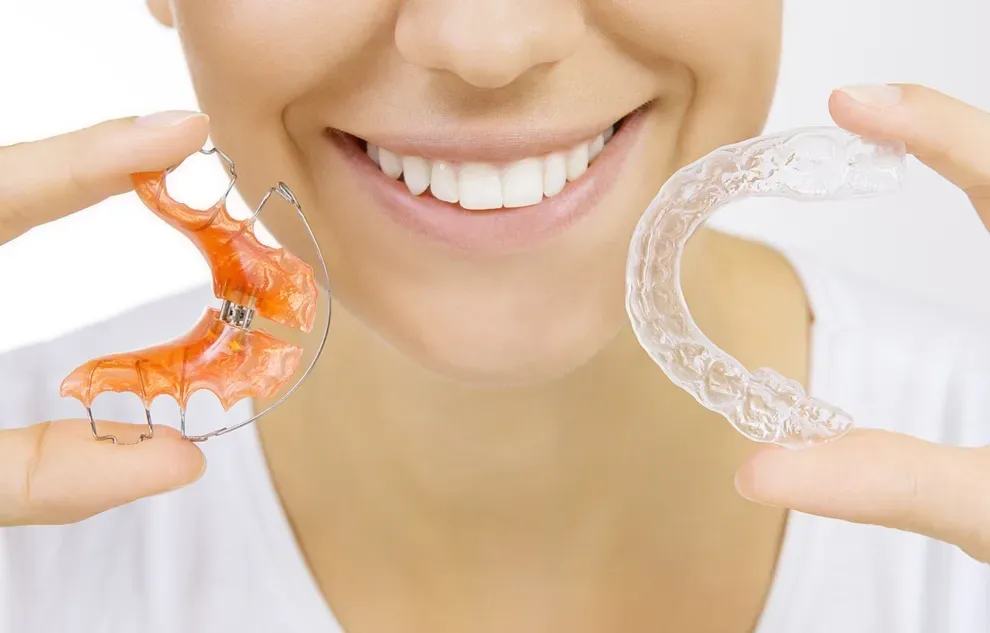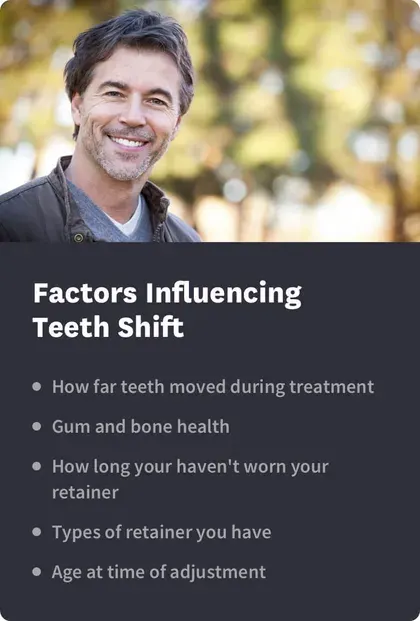What Happens to Your Teeth if You Don’t Wear Your Retainer?

Table of Contents
- Teeth Shifting
- Teeth Shifting Timeframe
- Influencing Factors
- Retreatment
- Immediate Consequences of Not Wearing a Retainer
- Long-Term Risks of Irregular Retainer Use
- What to Do if Your Retainer Doesn’t Fit Anymore
After you complete your braces or aligner program, you’ll need to wear a retainer to keep your teeth in place. Otherwise, your teeth can move, and you’ll lose your corrected bite and smile.
This post-treatment time is called your retention period. A retainer is used to “retain” your corrected tooth and bite position. Your retainer will be worn full-time (up to 22 hours a day) for four months to a year and part-time (only at night) after that indefinitely.
Teeth naturally move and shift, and other issues (like teeth grinding and decay) can also cause them to move. To ensure your teeth don’t move back to where they were before you wore braces or clear teeth aligners, you’ll likely have to wear a retainer at night for the rest of your life.
Retainers are an important part of orthodontic treatment that help to keep your teeth straight.
Teeth Shifting Without Retainers
Your teeth will move throughout your life and braces or aligners can help to straighten them out. After treatment, retainers help to keep them in their new positions.
If you do not wear your retainer, the fibers in your gum tissue can pull your teeth back into the positions they were in before the braces or aligners forced them into the desirable places. The longer you go without wearing retainers, the more your teeth can shift.
Not wearing your retainer for a night or two is not likely to cause an issue, but if you continue to not wear it, the shift can become greater and greater. After about a week or so, it may be difficult to get your retainer to fit back into your mouth. If you do not wear your retainer for a long period of time, your teeth may end up reverting back to their initial positions.
How Long Does It Take to Shift?
How much your teeth shift without a retainer will depend on a number of factors, including genetics and the type of orthodontic problem you had before treatment.
Generally, a few days or even a week will not allow for severe teeth shifting. Most people will be able to get their retainer in easily and resume their retention period uninterrupted.
After a month of not wearing a retainer, teeth may have shifted significantly. If your retainer doesn’t easily fit over your teeth (if it feels uncomfortable or forced), it’s possible you may need a new retainer made or even another course of braces or aligner wear.
If you don’t wear a retainer for a year, it’s very possible your teeth have shifted and your old retainer will not be safe for use, and you’ll need to consult with your orthodontist about correction options.
If you’ve gone without your retainer for an extended period, your retainer isn’t fitting correctly, it’s causing you pain, or it appears damaged, check with your dental professional before wearing it. Wearing an ill-fitting retainer can result in tooth damage, irritated gums, and a stuck or damaged retainer.

Factors Influencing Teeth Shift
The amount of movement your teeth make can depend on several factors, including these:
How far your teeth needed to be moved in the first place
Your gum and bone health since bone loss can contribute to further teeth movement
How long you have not been wearing your retainer
What type of retainer you have, either fixed or removable
Your age at the time of adjustment
Adolescents may be able to stop wearing retainers after 10 or so years, while adults who had braces often need to wear retainers indefinitely.The longer it has been since you had braces or aligners, the more fixed your teeth may be. If you just got your braces off, your teeth are more likely to move out of place faster if you do not wear your retainer than if it has been 5 to 10 years since you had your initial orthodontic treatment. The first three months are the most critical time period to keep your retainers in place.
Immediate Consequences of Not Wearing a Retainer
A retainer is designed to support your teeth as they settle into their new spaces. While every mouth is different, research suggests that how much your teeth move in the first 3 to 12 months is indicative of what your smile will look like 10 to 12 years after orthodontic treatment.
In other words, the immediate consequences of not wearing a retainer can stick with you for decades. The shifts your teeth make now will persist.
Other immediate consequences can include discomfort, especially if your teeth aren’t clicking together properly. If your teeth move too much, you could feel intense pain if you try to push your retainer on your teeth.
Long-Term Consequences of Not Wearing a Retainer
Studies suggest that your teeth move most in the short period after your braces or aligners are removed. The rate and speed at which they move declines with time. However, the consequences of not wearing a retainer can stay with you for a long time.
After about 232 days, the alveolar fibers that connect your teeth to your jaw are reorganized. That means they are tightly connected to the jaw in their present position. If this much time has passed, it’s very difficult to use a retainer to push your teeth into place. Instead, you might need a new set of braces or aligners to shift your teeth incrementally.
What to Do if Your Retainer Doesn’t Fit Anymore
The consequences of not wearing a retainer can mean a poor fit when you try to use the device again. What you’ll do next depends on how poorly it fits.
If you can slip the retainer over your teeth relatively easily, you can start wearing your device as your orthodontist recommended. It may be slightly uncomfortable to do so, and you may need a few days to adjust. If you can’t handle the discomfort, ask your dental professional for advice.
If you can’t put the retainer over your teeth easily, don’t force it. Don’t push, pull, or shove the device in place. You could chip your teeth, damage your gums, or otherwise cause pain. If it doesn’t fit, set the device aside and make an appointment with your dental professional. Together, you can decide on the appropriate next steps.
Retreatment After Not Wearing a Retainer
Retainers, especially fixed retainers, can help to maintain the alignment of your teeth most of the time (90 percent); however, rarely, your teeth can move even with a retainer. In these cases, your orthodontist may need to adjust your retainer or overall treatment plan.
Always wear your retainer exactly as directed, either by the aligner treatment company or your orthodontist.
If you go an entire month or more without wearing your retainer, your teeth will likely shift back to a point where you will no longer be able to fit your retainer in your mouth. At this point, you will potentially need to revisit an orthodontic treatment plan. This can include going back to braces or aligners.
Braces and aligners adjust your teeth. Retainers keep the changes in place, holding the adjustment. Retainers are a vital part of orthodontic treatment and should be used as directed.
